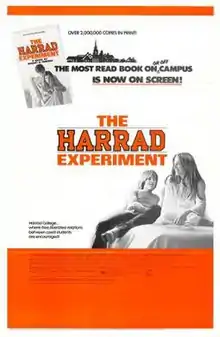| The Harrad Experiment | |
|---|---|
 Theatrical release poster | |
| Directed by | Ted Post |
| Written by | Michael Werner Ted Cassidy |
| Based on | The Harrad Experiment by Robert H. Rimmer |
| Produced by | Noel Marshall Mel Sokolow Dennis F. Stevens |
| Starring | James Whitmore Tippi Hedren Don Johnson Bruno Kirby Laurie Walters Victoria Thompson |
| Cinematography | Richard H. Kline |
| Edited by | Bill Brame |
| Music by | Artie Butler |
| Distributed by | Cinerama Releasing Corporation |
Release date |
|
Running time | 97 minutes |
| Country | United States |
| Language | English |
| Budget | $400,000[1] |
| Box office | $3 million (US/Canada rentals)[2][3] |
The Harrad Experiment is a 1973 coming-of-age film about a fictional school called Harrad College where the students learn about sexuality and experiment with each other. Based on the 1966 novel of the same name by Robert Rimmer, this film deals with the concept of free love during the height of the sexual revolution, which took place in the United States during the late 1960s and early 1970s.
The movie stars James Whitmore and Tippi Hedren as the married couple who run the school, and includes a young Don Johnson as one of the students who tries to go beyond the rules. It was directed by Ted Post. The screenplay was co-written by Ted Cassidy and Michael Werner based upon Rimmer's novel.
A sequel, Harrad Summer, was released in 1974.
Plot
Cast
- James Whitmore as Philip Tenhausen
- Tippi Hedren as Margaret Tenhausen
- Don Johnson as Stanley Cole
- Bruno Kirby as Harry Schacht (as B. Kirby Jr.)
- Laurie Walters as Sheila Grove
- Victoria Thompson as Beth Hillyer
- Elliott Street as Wilson
- Robert Middleton as Sidney Bower
- Billy Sands as Jack
- Sharon Ullrick (née Taggart) as Barbara
- Maggie Wellman as Cynthia
- Michael Greene as Yoga Instructor
- Ron Kolman as Evan
- Eric Server as Workman
- Robert C. Ross as Workman
Appearing in uncredited roles are Ted Cassidy as a diner patron, Melanie Griffith and Gregory Harrison as students, Melody Patterson as Jeannie, Dennis F. Stevens as a heckler at the Ice House, and George Memmoli, Bill Saluga, and Fred Willard as Ace Trucking Company employees.
Home media
The film was released on DVD on May 22, 2001 by Marengo Films.[4]
Reception
In The Boston Phoenix, Steve Vineberg reviewed the film negatively, writing, "It's more or less tailored to the suburban set who don't feel up to Last Tango in Paris."[5] He added, "The Harrad Experiment can probably be summed up by its opening and closing sequences — it begins with one of the girls wandering around the new campus and hugging a tree, and ends with the two couples whose relationships are the heart of the film clasping hands, repeating some inane contact exercise, and finally falling into a four-way embrace."
Time Out said that while Ted Post had employed long, "voyeuristic" takes and the theme music was poor, the film had more appeal than his other work and deserved its success.[6]
See also
References
- ↑ "'Harrad' Film Isn't 'Another Dirty Movie'". Sarasota Journal. April 21, 1972. p. 8C – via Google News Archive.
- ↑ "Big Rental Films of 1973". Variety. January 9, 1974. p. 19.
- ↑ Donahue, Suzanne Mary (1987). American Film Distribution: the Changing Marketplace. UMI Research Press. p. 294. ISBN 978-0835717762.
- ↑ Tribbey, Ralph (March 30, 2001). "DVD NEWS BRIEFS: Marengo's 'Killer B's'; BFS' 'Sharpe's' Series; MGM's May Slate; A&E;'s 'Pearl Harbor'; Vanguard's June". hive4media.com. Archived from the original on April 9, 2001. Retrieved September 14, 2019.
- ↑ Vineberg, Steve (June 12, 1973). "The Harrad Experiment". The Boston Phoenix. Vol. 2, no. 24. p. 4. Retrieved September 1, 2023.
- ↑ "The Harrad Experiment". Time Out. September 10, 2012. Retrieved December 18, 2019.